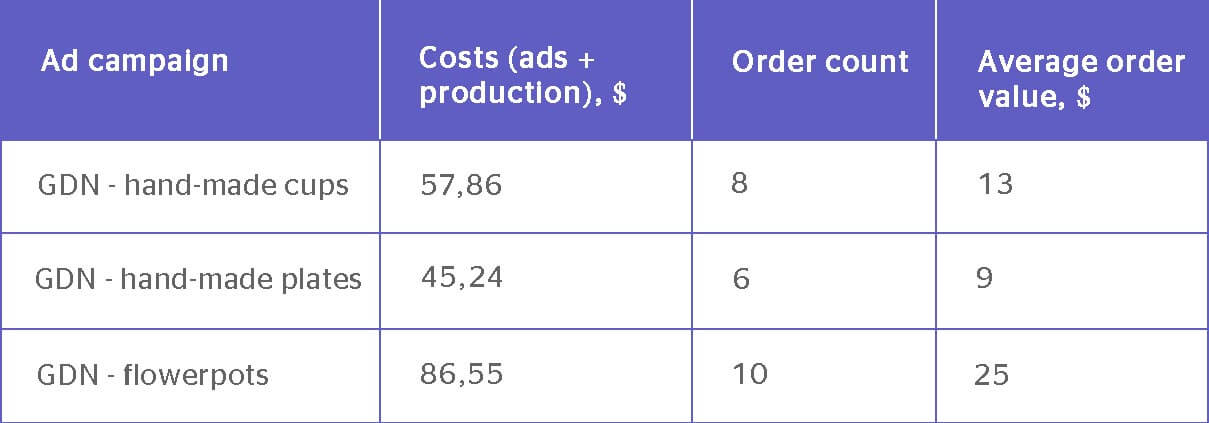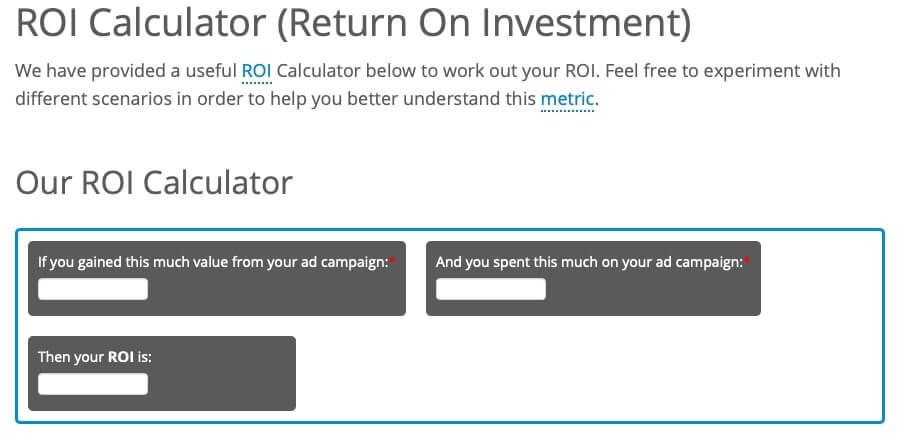The ROI formula: How to Calculate It and Why Your Marketing Needs It

Is the ROI of 120% good or bad? What does this metric affect and what to do after you’ve calculated it? How is it related to your revenue and how to increase them keeping the metric in mind?
Many businessmen ask themselves these questions as ROI is one of the important marketing metrics along with LTV, ARPU, and NPS. Let’s figure out how the ROI helps evaluate the efficiency of marketing channels and how it should be put to good use to ensure business success.
What is the ROI?
The ROI (Return on Investment) shows the ratio of how much your investments pay off, in a nutshell. This metric shows how profitable (or unprofitable) your product or project is.
Investments mean exactly your contribution to the business, namely your salary fund, tenancy expenses, marketing, purchasing raw materials, software, and all other stuff you need for work.
You need to calculate the ROI if you want to find out how well your investments in the team, project, or advertising campaign pay off. This metric is often used to calculate the efficiency of various advertising channels: paid search or display ads, targeted ads on social media, leaflets, or indoor advertising. It’s the ROI that helps you identify your investment profitability.
Example:
Let’s say we’re producing shampoos and want to know how efficient our Facebook ad campaign was. Calculating the ROI can help us here: we’ll see how well advertising expenses paid off together with shampoo manufacturing expenses.
Why calculate ROI?
Calculating the ROI helps you make managerial decisions and avoid costly mistakes as well as see how profitable your projects are. That’s why the ROI is one of the major metrics you should use to determine the direction of your business and decide what to do not to fold up.
Are ROI, ROMI, and ROAS different?
The ROI is often mistaken for ROMI; ROMI, in turn, — with ROAS, and vice versa. Let’s see what makes these metrics different.
ROI (Return on Investment) is the return ratio of your investments. It helps you see how profitable your whole project is with all investments taken into account. If you want to calculate the ROI, you need to take all project expenses and revenues and use the below formula.

ROMI is the return ratio of your marketing investments. ROMI is most often mistaken for ROI. While ROI helps you calculate the return on all investments, ROMI only takes marketing expenses into account: your advertising budget, printed material expenses, billboard lease, and so on, and it doesn’t consider manufacturing expenses.

ROAS shows the Return ratio of your Advertising Spend. ROAS only considers your spending on a certain ad campaign. The major job of this metric is to help see if a company makes revenues using advertising channels used.

The ROI formula
There’s a whole lot of ROI formulas. The below one is the simplest and most effective:

Revenue is all money a company gets for a period of time. Expenses are costs and investments. When we’re calculating the ROI of a particular project, we’re only taking revenue it generates into account. As for expenses, we only consider the ones on this particular project. The calculation results are in percentages.
Read also:
👉 Live Chat Best Practices: 20 Hacks to Make Customer Service Better
👉7 Best Live Chat for eCommerce: Boost Conversion on your Website
👉 Top 5 live chat mobile app: find the best fit for your business
👉 Live Chat: How Online Chat Tool Can Help Your Business
👉 20 Best Live Chat Software for your website chat service
👉 Acquisition funnel marketing: Grow customer conversions at each step of user journey
👉 The top 15 inbound marketing tools: harness digital power and elevate your business
👉 10 best website personalization tools to deliver top-notch visitors experience
👉 7 best email capture tools: features and pricing compared for 2024
ROI shows the difference between your revenue and expenses. When one component changes, the whole proportion does so, too.
Example:
Let’s imagine you run a hand-made ceramics shop. You’ve just launched and run a wonderful website.

Suppose you have a similar product range
Later, you’ve decided to run ads to acquire your first customers.
So here’s what came of it:

Now let’s look at every campaign in more detail. We’ll start with hand-made cups.
You’ve spent $57,86 on advertising and sold 8 cups for $15 each. The production cost of one cup is $300.
ROI = 8*13 — 57,86 / 57,86 * 100% = 79,7%
ROI of the cup campaign is — 79,7%
The cup advertising campaign isn’t making you any profit, quite the contrary.
Let’s calculate the ROI for the plates campaign.
ROI = 6*9 — 45,24 / 45,24 * 100% = 19,4%
ROI of the plates ads is 19,4%
This ad campaign is detrimental, you need to stop it.
Finally, let’s calculate the ROI of the flowerpot ads.
ROI = 10*25 — 86,55 / 86,55 * 100% = 188,9%
ROI of the flowerpot ads is 188,9%
Flowerpots rock and the campaign paid off. But is everything as good as it looks?
How high should the ROI be?
ROI is the ratio metric that’s not representative in isolation. Your ROI can be high while overall revenue is low. If you only rely on the ROI and don’t know your real income and expenses, you can’t be sure you’re getting maximum revenue.
If you’re selling at maximum capacity and getting maximum revenue (we’re not talking about price increases here), it’s time to optimize channels and increase the ROI. If not yet, first, you need to reach this maximum point, hence, invest in your distribution expansion. Invest more in advertising and decrease your ROI a little.
Let’s consider an example.

Let’s say we have two campaigns promoting the same product as cups. In the first campaign, the ROI is much higher at 105%. This campaign is seemingly more successful. But the second campaign helped sell more items and double profits.
Suppose you can manufacture 50 flowerpots a month at your current capacity. But most likely, you’re not going to sell all of them, and the rest will gather dust on your warehouse. You can increase advertising investments more and more until you sell 50 flowerpots a month, provided that the ROI > 100% and your campaigns are making profits. When you reach this point, you can turn to ad cost optimization and increasing the ROI.
When should I calculate the ROI?
Bear in mind that the ROI refers to an action. These metrics are called actionable. There are metrics you may see and feel either happy or sad, but you can’t tell if something’s wrong and what you should change (like churn rate or subscriber count). Actionable metrics directly show what needs to be changed.
ROI is not the conversion rate formula; you can’t calculate it in the background. One calculates the ROI when they need to make a managerial decision, like purchasing equipment or raw materials, using/not using advertising channels, “blacking out” a loyalty program, or giving it the right to exist.
When calculating the ROI, consider a period with no dramatic changes in your ads, distribution, or production methods.
How to calculate the ROI: Excel vs. Online
You risk mixing up essential metrics or even missing them when calculating the ROI. Luckily, there are ways to calculate the ROI automatically that help mitigate this risk. You can use Excel spreadsheets or special calculation software.
The Online Advertising Guide is a standard calculator with all necessary variables.

Alternatively, you can use an Excel workbook where you can also store all your past calculations.
How are the ROI and CRR different?
Cost Revenue Ratio indicates the expenses as a percentage of revenue. The CRR is similar to the ROAS and indicates the ratio of advertising spend to revenues generated from it. This metric helps you see how much of the generated revenue is spent on advertising.
The CRR formula:
CRR = Advertising spend/Revenues generated from ads * 100%
Let’s get back to our cups. We’ve spent $94 on cups ads and earned $104 from it (8 cups for $13 each).

The CRR of the cups campaign is 94 / 104 * 100% = 90,4%
This means we’re spending 90,4% of our revenues from cups on advertising them.
Unlike the ROI, the CRR helps you see the share of advertising spend in ad revenue. Thanks to this metric, we can conclude if our project or an ad campaign is profitable. The CRR should not exceed 100%, otherwise, an ad campaign can be considered detrimental.
I’ve made my ROI calculations. What’s next?
If we’re talking about paid ads, after calculating the ROI, it’s time to finetune your ads; stop detrimental campaigns and adjust budgets to improve your distribution without more expenses.
When it comes to other expenditures, you’ll see where you can improve efficiency or vice versa, what else you can invest in.
Experiment. Test your new ideas. Run new campaigns. Adjust your focus when you see you’re moving the wrong way.
The key value of the ROI is that it lets you make “affordable” mistakes. Make them, learn the lessons, and find your right path.
Wrapping up with Frequently Asked Questions
The ROI demonstrates your rate of return of your investments into the business. You need it to evaluate the efficiency of your project and your team. Your salary fund, tenancy expenses, purchasing raw materials, software, and access to various SaaS are all business investments that you need to bear in mind.
If we’re calculating the ROI of an ad campaign or a project, we should only consider revenue from these projects or campaigns. As for costs, only include your spending on a particular project or campaign. If we’re curious about the profitability of a marketing campaign (ROMI), we’re only considering our expenses within this campaign. For example, we’re taking into account our expenses on printed materials, billboard lease, and so on, and we don’t consider manufacturing expenses.
The calculation results are in percentages.
Here it is:






